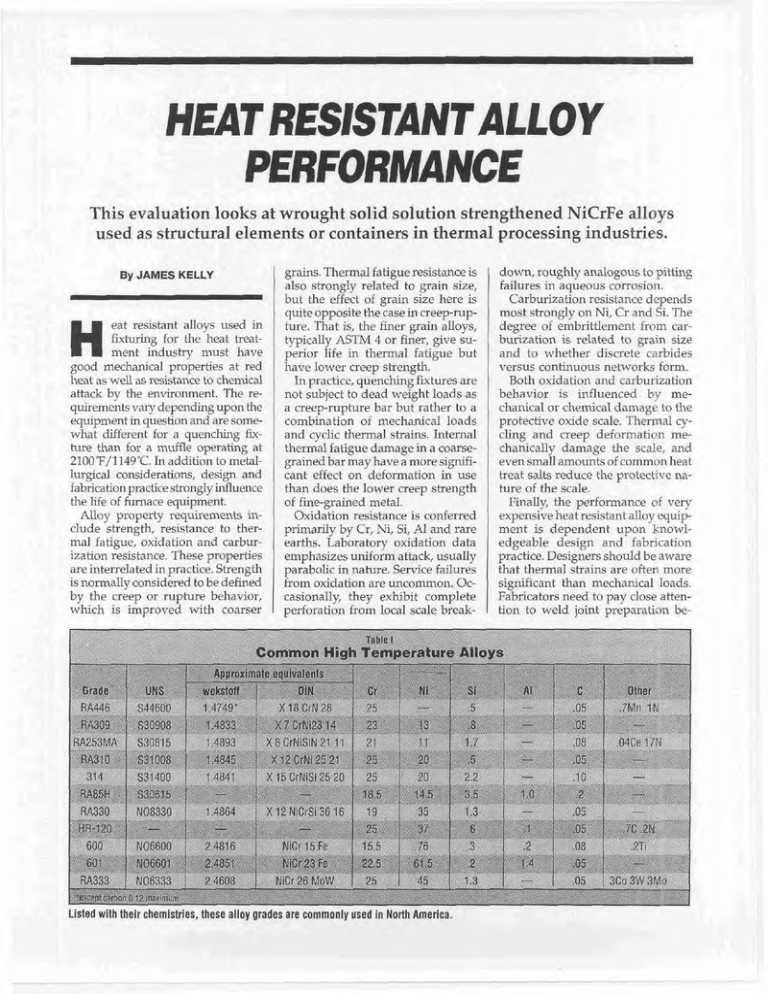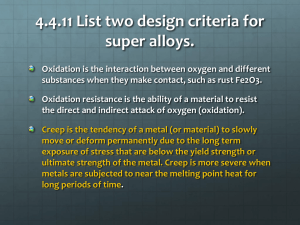
HEAT RESISTANT ALLOY
PERFORMANCE
This evaluation looks at wrought solid solution strengthened NiCrFe alloys
used as structural elements or containers in thermal processing industries.
By JAMES KELLY
eat resistant alloys used in
fixturing for the heat treatment industry must have
good mechanical properties at red
heat as well as resistance to chemical
attack by the environment. The requirements vary depending upon the
equipment in question aud are somewhat different for a quenching fixture than for a muffle operating at
2100'F/1149'C. In addition to metallurgical considerations, design and
fabrication practice strongly influence
the life of furnace equipment.
Alloy property requirements indude strength, resistance to thermal fatigue, oxidation and carburization resistance. These properties
are interrelated in practice. Strength
is normally considered to be defined
by the creep or rupture behavior,
which is improved with coarser
H
grains. Thermal fatigue resistance is
also strongly related to grain size,
but the effect of grain size here is
quite opposite the case in creep-rupture. That is, the finer grain alloys,
typically ASTM 4 or finer, give superior life in thermal fatigue but
have lower creep strength.
In practice, quenching fixtures are
not subject to dead weight loads as
a creep-rupture bar but rather to a
combination of mechanical loads
and cyclic thermal strains. Internal
thern~alfatigue damage in a coarsegrained bar may have a more significant effect on deformation in use
than does the lower creep strength
of fine-grained metal.
Oxidation resistance is conferred
primarily by Cr, Ni, Si, A1 and rare
earths. Laboratory oxidation data
emphasizes uniform attack, usually
parabolic in nature. Service failures
from oxidation are uncommon, Occasionally, they exhibit complete
perforation from local scale break-
Listed with their chemistries, these alloy grades are commonly used in North America
1
'
1
,
down, roughly analogous to pitting
failures in aqueous corrosion.
Carburization resistance depends
most strongly on Ni, Cr and Si. The
degree of embrittlement from carburization is related to grain size
and to whether discrete carbides
versus continuous networks form.
Both oxidation and carburization
behavior is influenced by mechanical or chemical damage to the
protective oxide scale. Thermal cycling and creep deformation mechanically damage the scale, and
even small amounts of common heat
treat salts reduce the protective nature of the scale.
Finally, the performance of very
expensive heat resistant alloy equipment is dependent upon knowledgeable design and fabrication
practice. Designers should be aware
that thermal strains are often more
significant than mechanical loads.
Fabricators need to pay close attention to weld joint preparation be-
Table II
Table Ill
Intergranular Attack in
Molten Salt Bath
Oxidation Resistance
.. .- ..
..-..
Grade
-.
.. ..
.. .-.
..
Attack .Depth,
mils- ..
...
..
..... .
-..... .
-
..
-.-..
ssion, mil
-
..
RA33:
These ailov specimens were exposed for
21 days tol0'to 12 cycles per day. The
cycles consisted of preheat salt at 1300°F.
transfer to 816°F preheal salt, then to high
heat salt at 2200°F. followed by quench in
1100°F salt, then air cooled,
cause incomplete joint penetration
is the most common cause of weld
failure in service.
The alloys to be addressed in this
paper are those wrought solid solution strengthened NiCrFe alloys
used as structural elements or containers in the thermal processing
industries. Service temperatures
range from below 1400T/760"C to
2300T/1260°C, atmospheres from
vacuum to carburizing, and thermal
cycling from furnace cool to brine
quench. Corrosive environmentscan
be as benign as air or severe as hot
chloride fumes and molten metals.
Alloys
Some of the alloy grades most
commonly used in North America
are listed in Table I.
The high chromium ferriticRA446
has very low hot strength, about an
order of magnitude less than the
austenitic grades. RA446 is used
primarily for resistance to oxidation,
sulfidation or molten copper, for
which strength is not a requirement.
Large bars (e.g. 2 x 4 in. rectangle)
are used for electrodes in neutral
salt pots up to 2350'F/1288'C.
Austenitic grades RA309 and
RA310 are used primarily for oxidation resistance at 1900T/1038'C to
2000T/1093'C. They offer moderate creep strength and, for nickelbearing alloys, good hot corrosion
resistance. RA253MA has exceptionally high strength and oxidation
resistance through 2000T/1093"C
and is used in annealing covers, radiant tubes, kilns, hot dampers, cy-
This RA85H drill tixture is used jllst above
salt level in lhe fumes at a temperature of
about 1500°F.
clones and coal-fired burners. This
cerium bearing grade performs best
under oxidizing conditions.
The silicon content of 314 provides
good oxidation and carburization
resistance for use in retorts and
muffles. In the United States since
the 1960s, type 314 has been supplanted by R.4330.
RA85H, RA330, 600, 601 and
l<.4337 !lc1vt, $#loci <trell<th .111~!
c,irburir.itiu~iresist.~nc.e,t \ i t h o\idation resistance ranging from very
good to excellent.
RA85H relies on 3.5percent Si and
1 percent A1 for carburization resistance similar to RA330, with oxida-
II
Tests ar z i u u - t in weeklv cvcles to 3.000
hours show RA333 subject io only one.
third to one-sixth the metal loss of other
commonly used heat resistant alloys.
tion resistance superior to 309. In
addition, this high silicon level provides good resistance to attack by
chloride salts. (Table 11)
RA85H is used for a variety of salt
bath fixturing. The one shown in
Figure 1 operates just above the salt
in corrosive fumes.
RA333 has perhaps the best combination of stren,@h and oxidation re-
I niatcr1.1l5
' . ' Tcts
51.~t~11i~c~~rti1~~~~~iim1?cc1~illy~~v~ii
CII 2111O'Ft I IN i
show only one-third to one-sixth the
metal loss, calculated from weight
measurement, of other commonly
used heat resistant alloys? (Table Dl)
Cyclic oxidation tests run over 7,500
Operating at 1700'F. the nitrogen-cerlum strengthened RA253MA in Flgure 2a shows no
deformation, but the 309 stainless inner cover shows marked creep buckling.
1
Heat resistant alloys
~
.=-~--
Thermal Fatigue
100 X
hours at 1900"F/1038'C demonstrate
long-time oxidation resistance supenor to the aluminum bearing alloy
601.' The strength and oxidation resistance of R.4333 permit this grade
to be used as thin as 11gauge sheet in
copper brazing muffles and gas-fired
radiant heating tubes.
Strength
Above 1000'F/538T, a common
definition of strength is the stress to
cause a minimum creep rate of 0.0001
percent per hour. The practical effects
Table IV
Rupture Strengths
1
It is Quite oossihle for several orades to
haues~miiarrupture strengths but vary
widely in resistance to creep deformation.
of creep shength areiuushated in Figures 2a and 2b. At 1700?/927T operating temperature, the nihogen-cerium strengthened RA253MA shows
no deformation as compared with
marked creep buckling in 309 stain-
The direction of crack propagation in this 35Ni-19Cr alloy is from left to right,
less. Considering that there is afactor
of three or four difference in measured creep rate between these two
grades, this relative service performance is to be expected.
Stress to rupture is another conimonly used measure of high temperature strength. However, it does
not necessarily predict the relative
resistance to deformation among
various alloys. It is quite possible
for several grades to have similar
rupture strengths but vary widely
in resistance to creep deformation.
For example, in Table IV at 1800P/
982'C, grades 309 and 310 have 90
percent and 105 percent, respectively, of the rupture strength of
RA330. But the creep strengths of
309 and 310 are both less than 60
percent that of RA330.
High temperature shear strength
is important for the '/rto 1-in.-di-
1 1
Figure 3
ameter pins used in cast-link furnace belts in North America. For
the link design of Figure 3, the pins
bear the shearing loads imposed by
belt and workload weight and by
the force necessaly to pull the belt
through the furnace.
If the pin lacks shear strength, the
failure mode is "crank-shafting," as
shown in Figure 4. The most common pin alloy in the United States
is RA330HC, a 0.4 percent carbon
version of RA330. Requirements for
higher strength pins lave beenmet
by alloy R.4333 and, more recently,
by Haynes alloy HR-120.
With an interlocking design, the
cast link itself bears the shearing
stresses, and a high strength pin is
not required. In this case, pins of
RA330 %&in.hexagonal bar provide
adequate strength. Hexagonal pins
are used to continually scrape away
Figure 4
2 I
High temperature shear strength is important in this pin
bearing Ilnk cast of 35 Ni 17Cr .4C alloy because as part of
a cast-linkfurnace belt it must hear shearing loads.
As a consequence of improper annealtng, this belt pin lacks shear strength;
its failure mode is called crank-shafting.
1
carbon deposits that would otherwise tend to prevent the belt from
flexing over the drive drum.
Thermal fatigue problems are far
more common than creep-rupture in
heat treating furnace equipment. The
nature of the business includes thermal shock ranging from air cool to
water quench from red heat with alloys that typically expand 0.2-in.-perfootfromOT/-18'C to1800'F/982"C.
Both thermal fatigue and creep-rupture are strongly influenced by the
metal's grain sue, albeit in opposing
manners. It is well known that a high
temperature anneal to produce a
coarse grain size improves creep-nrp
.
.
lur~~}~roperhcs.S~~ch
procc%int: 15 rr~iuirtdto clrvclon thc iull strcnctli ,>I
grades such as k08810 and ~Ou88111
However, in liquid quench applications, coarse grains almost invariably
result in short life due to thermal fatigue cracking. Specifically, in bar
frame heat treating baskets, a reasonably fine-grained size is required to
minimize thermal fatigue damage.'
Grain size also affects the life of steel
mill annealing covers when rapid
cooling is part of the cycle. Covers of
RA330 3/16-in. plate, 68-in. diameter
by 14ft.high, have typically lasted in
excess of seven years at one North
American mill. The maximum cover
temperature is reported at 1500F/
816"C, and the product anneal temperature, at 1375F/746-C. This cover
is water-spray cooled from about
Figure 6
Thermal Fatigue in Weld
Joints
Incomplete weld penetration, found in this
' ?-In -bar-lrarne basket constluctlon,will
tend to produce early f a ~ l J r due
e to
900T/48ZoC. RA330 is annealed to
develop a grain size typically in the
range of ASTM 4-7. Other producers
of 35%Ni-19Cralloy prefer to maximize creep strength by a grain-coars-,
ening anneal.
When a cover of such materialgrain size ASTM 2-was placed into
this same service, it developed severe
through-wall cracks within one year.
The microstructure in Figure 5
shows classic thermal fatigue cracks,
intergranular and heavily oxidized.
It is preferable to avoid the use of
deliberately grain-coarsened alloy
when the intended service is known
to include severe thermal shock.
Incompletely penetrated weld joints
tend to fail early in tbermal fatigue.
The unwelded area functions as a
crackand grows outward through the
weld during each thermal cycle. Indeed, lack of full penetration is the
most common cause of weld joint
failure in high temperature service.
Figure 6 illustrates an unfortunately
common weld joint design used in
bar frame basket construction.
While the RA85H bars retained 43
percent tensile elongation at room
temperature, the welds broke. Originally a cross, the completely fractured weld is to the left. The initial
unwelded condition still may be
observed at the right side. This problem could be minimized by cutting
a dull chisel point on the bar ends to
permit the welder to make a completely penetrated joint.
James Kelly is director of technology at
Rolled Alloys. Temperance, Mich.
References
1. Gene Rundeli and James Mcconnell. "Oxidation Resistance d Eight eat ~ e r i s t a n ~
t l l o y sat 870'. 980~.
109s
and 115VC." Oxidation of Metals. Val. 36. No. 314. Oc(.
1991
2. A. ROY. FA. ~ a g s nand J.M. Cowin. "Performance of
Heaf-ResistantAlloys 8n Emwslan-Control Systems." SAE
7anns3
.
3. Gene Rundeli. "Evaluatlan ot Heai Resistant Alloys I"
Composite Fixtures." NACE paper No. 377. 1986.
Reprinted from July 1993 issue o f t{EAT TREATING *I993 HITCHCOCK PUBLISHING (2OMPANY ALL RIGHTS RESERVED
ROLLED
ALLOYS
Heat and Corrosion Resistant Alloy Specialists



